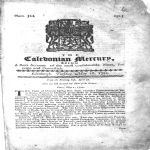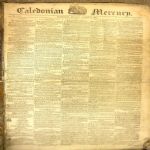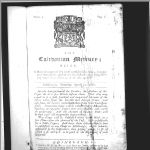Detailed Record
Caledonian Mercury, The;
no 1, 28 Apr 1720 - 1859
then: Caledonian Mercury and Daily Express. no 21817, 29 Aug 1859 - no 21967, 21 Feb 1860
then: Caledonian Mercury. no 21968, 22 Feb 1860 - no 24278, 20 Apr 1867//
then: Caledonian Mercury. no 21968, 22 Feb 1860 - no 24278, 20 Apr 1867//
Edinburgh,Midlothian (1720 - 1867)
Robert Allan
Thomas Allan
James Brown (Dr. 1827 - 1830)
James Browne (1855 - 1866)
Jones? Browne (Dr.)
W. Browning Bruce
David Buchanan
J.D. Cochrane
James Grant
McLaren (1829)
McLaren
James Robie (1855 - 1866)
William Rolland
William Saunders
Alexander Symmers
Thomas Allan
James Brown (Dr. 1827 - 1830)
James Browne (1855 - 1866)
Jones? Browne (Dr.)
W. Browning Bruce
David Buchanan
J.D. Cochrane
James Grant
McLaren (1829)
McLaren
James Robie (1855 - 1866)
William Rolland
William Saunders
Alexander Symmers
Robert Allan (1760-1790+)
Thomas Allan (-1860)
John Robertson (1772 - 1760?)
James Robie (1860-1866)
Thomas Ruddiman (1729 - 1760?)
Walter Ruddiman (-1742)
William Saunders (1866-1867)
Edward Spender
James Steuart
Thomas Allan (-1860)
John Robertson (1772 - 1760?)
James Robie (1860-1866)
Thomas Ruddiman (1729 - 1760?)
Walter Ruddiman (-1742)
William Saunders (1866-1867)
Edward Spender
James Steuart
W. Jr Adams
Robert Allan (1790)
Thomas Allan (1852 - 1855)
William Lindsay (1855 - 1867)
Robertson (1776)
W. Rolland (1720 - 1867)
Thomas Ruddiman
T. Ruddiman & Co (1746 - 1748)
Thomas Allan and Co (1829)
Thomas and Walter Ruddiman
Robert Allan (1790)
Thomas Allan (1852 - 1855)
William Lindsay (1855 - 1867)
Robertson (1776)
W. Rolland (1720 - 1867)
Thomas Ruddiman
T. Ruddiman & Co (1746 - 1748)
Thomas Allan and Co (1829)
Thomas and Walter Ruddiman
William Adams (Jr) 1720 - 1867)
Robert Allan
John Robertson (1798-)
Thomas Ruddiman (Sr) 1724 - 1771)
Walter Ruddiman (1768)
Robert Allan
John Robertson (1798-)
Thomas Ruddiman (Sr) 1724 - 1771)
Walter Ruddiman (1768)
John George Cochrane
Andrew Belfrage Picken (1820's)
Andrew Belfrage Picken (1820's)
Size:
fol (1720 - 1786); fol, 6pp (1720); 4to 4pp; 54cm, 4pp (1829); 61cm, 4pp (1855)
Price:
½d (01 Aug 1745 - 18 Sep 1745); 7d (1829); 4 1/2d (1846-1855); 1 1/2d, 2 1/2dst (1855); 1 1/2d, 2 1/2dst (1856); 1d, 2dst (1864)
Circulation:
838 (Jan-Jun 1837); 769 [Jan-Mar 1839); 846 (Jan-Mar 1840); 800 (Jun-Dec 1841); 769 [Apr-Jun 1842); 953 (Jul-Dec 1842); 846 (Apr-Jun 1843); 101,000/a (1845); 1,000(1847); 106,512(1850); 1.145/ho(1855); 1.400/w.
Frequency:
thrice weekly (28 Apr 1720-1845?); twice weekly (Mon Thu 1846-1854); daily (1855-1856); twice weekly (14 Jul 1866- )
Illustration:
illustrated
Issued by:
Society of Writers to H.M. Signet
news stories from London and Edinburgh papers, regional news, commodity prices, local advertisements, legal notices, political articles, commerce, agriculture, parliament, law, local news, literature, culture
Orientation:
whig
Merges:
incorporated Edinburgh Guardian (1859); absorbed Daily Express (1859); absorbed Weekly Herald (1859); absorbed by The Scotsman (1867)
Andrews, History of British Journalism: 294, 298.; BLC Consolidated List.; Brown, Paisley Poets, (vol 1) 1889. p.430.; COPAC; DNB iv, p.619; Ferguson, Directory of Scottish Newspapers; Mitchell's; James H. Jamieson, Bibliography of East Lothian, Edinburgh (1936); NCBEL (vol 3); Gillespie, A Hundred Years of Progress p.12; AJNQ 1 (1908), p.139; Jack, Scottish Newspaper Directory, pp.61-62.; Norrie, pp.4-6. (1891).
Aspinall, Arthur. Politics and the Press c.1780-1850. Brighton, Eng.: The Harvester Press Limited, 1973.; Beals, "Textual Reappearance and Attribution in the Caledonian Mercury".; Black, Jeremy The English Press 1621-1861. Stroud: Sutton Publishing, 2001: 133.; Boyce, George, et al, eds. Newspaper History from the Seventeenth Century to the Present Day. Beverly Hills, CA: Sage Publications, 1978.; Brims, "Sources for historical research".; Couper, SNQ 8:3s (Dec 1930), p.232.; Couper, SNQ 8:2s (Nov 1906), pp.72-74; (Jan 1907), pp.107-109.; Cowan, p.417.; Escott, T. H. S. Masters of English Journalism: a Study of Personal Forces. London: T. Fisher Unwin, 1911.; Fyfe, William Chambers and the Business of Publishing.; Harris, "Literary Journalism, 1707-1918," p.311.; Machin, G.I.T. Politics and the Churches in Great Britain, 1869 to 1921. Oxford: Clarendon Press, 1987.; Mercurius Caledonius—Fac Simile of Mercurius Caledonius of Jan 08 1861.; Murray, "Newspapers" pp.376-377.; Sinclair, Fifty Years of Newspaper Life.; Thomson, Paper Industry in Scotland.
Described as the most "ancient general newspaper in Scotland" (Mitchell's 1846).
The Caledonian Mercury appeared in 1720, and was a "Jacobite paper which became the organ of the Highland Army in '45, and which was printed and owned by Thomas Ruddiman from 1729" (Gillespie).
BLC: "It was claimed that the Mercury's readership, based in Edinburgh and the eastern lowlands, consisted of the landowning class, the higher and middle classes, and shopkeepers, but increasingly the upper echelons of society turned to the Scotsman" (10).
In 1837, the Mercury was "without an editor, being conducted by a knot of young Whig lawyers, suckling politicians and expectant commissioners, who, gratuitously, it is said, furnish the requisite 'leaders.' ... Owing to its slavish adherence to the pseudo-Liberalism of the day, it has lost a good deal of its standing and influence in Edinburgh. It is very economically conducted, and is to say the truth a poor concern".
In 1839 further additions were made. On the abolition of the stamp duty in 1855, it appeared daily. "A sentence or two from the Scottish Newspaper Directory of the time will indicate the character of its contents: 'It is essentially a political newspaper, and a consistent supporter of the Liberal party. The leading articles are generally fair expositions of the party to which it is attached "well written, but seldom characterised by original or striking ideas. Commerce and agriculture obtain a share of notice. Nearly a third of the space contains advertisements. Its politics not being extreme, it is read by all parties, and is a favourite family paper with the better class of shopkeepers. In 1776, an attempt was made to develop a daily issue of the Mercury but the cautious publisher, Robertson, simply sent out a supplementary paper which appeared on the days when the Mercury was not published. Accordingly, on May 31,1776, the Caledonian Gazetteer was begun. It lasted for the suggestive thirteen numbers only, and then Robertson, apparently satisfied with the results, dropped the Gazetteer (June 27). and published the Mercury on 5 days of the week". However, this did not last, due to cost, and "the Mercury reverted to its tri-weekly appearance" (Monday, Wednesday, Friday, at a price of 3d)...
Around this time, the 1760s and 1770s, was "one of the two most influential and enduring Edinburgh newspapers of the eighteenth century, began to develop an important role as a vehicle for discussion of cultural, moral, and social issues" (Harris 311).
At the opening of the nineteenth century. The Caledonian Mercury partook of the general characteristics of the journals of the time. It was a commonplace production, though it did sometimes speak in a bolder key than its contemporaries.... For some time, an evening edition was also sent out "at 4:30, price l/2d., the avowed object of which was to improve the circulation of news on local matters. This arrangement continued for a fortnight only, and on Monday. July 16, 1866, the Mercury appeared wholly as an evening paper, 4pp., 5 columns to the page, and in a smaller folio. The price was l/2d" (Couper, SNQ 8:1s).
"Newspaper reporting also came to play a greater role in contested elections. To give a Scottish example, on 4 May 1768, the Caledonian Mercury devoted over two columns to the Cromartyshire election...it is significant that politicians competing for the support of a tiny Cromartyshire electorate of fewer than twenty should also have felt it important to create a favourable impression in the world of print" (Black, Jeremy).
In November 1829, there was "an extraordinary dispute" between the editors of The Caledonian Mercury and The Scotsman, arising out of attacks the former was allegedly making continually on the latter. It even resulted in a duel between the editors" (Couper, SNQ 8:3s).
"This paper was at the heart of was Robert Cowan deemed the 'first expansion' of the Scottish newspaper press after the post-Napoleonic boom in provincial titles but before the removal of stamp and advertising duties" (Beals 618).
Ironically, James Robie "sold it in 1866 to William Saunders, a London journalist. Saunders closed the Mercury in 1867 by selling it off to its bitterest rival, the Scotsman" (BLC).
After this proprietorship change, the Mercury marketed "itself exclusively as an evening newspaper." Saunders wanted "to provide Edinburgh with an evening newspaper" that would provide high quality, yet inexpensive news (Murray 376-377).
An advertisement in Jack (p. 159) says of the paper, "Originally established so far back as 1660, this Journal for a lime disappeared amidst the political distractions that ensued". Cowan writes this claim off as untrue and an attempt to give the paper added respectability: "The Mercury died in 1867 in spite of all that Robie had done to sustain it. In January, 1857, he paraded the names of Albany Fonblanque of the Examiner and other celebrities as prospective contributors. In 1859 he arranged the union of The Mercury and the Daily Express; and in 1861, by means of a bi centenary celebration, he linked, quite unwarrantably. The Mercury and the old Mercurius Caledonius, and looked to an equally impressive future under the guidance of new principles" (Cowan).
According to Cowan, it became a l/2d evening paper before the property was passed to the Scotsman (1867).
Among the contributors were Henry James Pye, 'Peter Pindar' and William Yates.
While many of its counterparts were focused locally, the Caledonian Mercury was one of the few which "sought to play a national role" (Brims).
"By the 1860s, it was attached to the Edinburgh Radical group, led by Duncan MacLaren, which represented, inter alia, the views of Presbyterian Voluntaryism" (BLC 10).
Murray concludes that "parochial affiliations and interests prevented the success of this scheme and the Mercury was terminated in 1867 after printing its 278th edition" (377).
The Caledonian Mercury appeared in 1720, and was a "Jacobite paper which became the organ of the Highland Army in '45, and which was printed and owned by Thomas Ruddiman from 1729" (Gillespie).
BLC: "It was claimed that the Mercury's readership, based in Edinburgh and the eastern lowlands, consisted of the landowning class, the higher and middle classes, and shopkeepers, but increasingly the upper echelons of society turned to the Scotsman" (10).
In 1837, the Mercury was "without an editor, being conducted by a knot of young Whig lawyers, suckling politicians and expectant commissioners, who, gratuitously, it is said, furnish the requisite 'leaders.' ... Owing to its slavish adherence to the pseudo-Liberalism of the day, it has lost a good deal of its standing and influence in Edinburgh. It is very economically conducted, and is to say the truth a poor concern".
In 1839 further additions were made. On the abolition of the stamp duty in 1855, it appeared daily. "A sentence or two from the Scottish Newspaper Directory of the time will indicate the character of its contents: 'It is essentially a political newspaper, and a consistent supporter of the Liberal party. The leading articles are generally fair expositions of the party to which it is attached "well written, but seldom characterised by original or striking ideas. Commerce and agriculture obtain a share of notice. Nearly a third of the space contains advertisements. Its politics not being extreme, it is read by all parties, and is a favourite family paper with the better class of shopkeepers. In 1776, an attempt was made to develop a daily issue of the Mercury but the cautious publisher, Robertson, simply sent out a supplementary paper which appeared on the days when the Mercury was not published. Accordingly, on May 31,1776, the Caledonian Gazetteer was begun. It lasted for the suggestive thirteen numbers only, and then Robertson, apparently satisfied with the results, dropped the Gazetteer (June 27). and published the Mercury on 5 days of the week". However, this did not last, due to cost, and "the Mercury reverted to its tri-weekly appearance" (Monday, Wednesday, Friday, at a price of 3d)...
Around this time, the 1760s and 1770s, was "one of the two most influential and enduring Edinburgh newspapers of the eighteenth century, began to develop an important role as a vehicle for discussion of cultural, moral, and social issues" (Harris 311).
At the opening of the nineteenth century. The Caledonian Mercury partook of the general characteristics of the journals of the time. It was a commonplace production, though it did sometimes speak in a bolder key than its contemporaries.... For some time, an evening edition was also sent out "at 4:30, price l/2d., the avowed object of which was to improve the circulation of news on local matters. This arrangement continued for a fortnight only, and on Monday. July 16, 1866, the Mercury appeared wholly as an evening paper, 4pp., 5 columns to the page, and in a smaller folio. The price was l/2d" (Couper, SNQ 8:1s).
"Newspaper reporting also came to play a greater role in contested elections. To give a Scottish example, on 4 May 1768, the Caledonian Mercury devoted over two columns to the Cromartyshire election...it is significant that politicians competing for the support of a tiny Cromartyshire electorate of fewer than twenty should also have felt it important to create a favourable impression in the world of print" (Black, Jeremy).
In November 1829, there was "an extraordinary dispute" between the editors of The Caledonian Mercury and The Scotsman, arising out of attacks the former was allegedly making continually on the latter. It even resulted in a duel between the editors" (Couper, SNQ 8:3s).
"This paper was at the heart of was Robert Cowan deemed the 'first expansion' of the Scottish newspaper press after the post-Napoleonic boom in provincial titles but before the removal of stamp and advertising duties" (Beals 618).
Ironically, James Robie "sold it in 1866 to William Saunders, a London journalist. Saunders closed the Mercury in 1867 by selling it off to its bitterest rival, the Scotsman" (BLC).
After this proprietorship change, the Mercury marketed "itself exclusively as an evening newspaper." Saunders wanted "to provide Edinburgh with an evening newspaper" that would provide high quality, yet inexpensive news (Murray 376-377).
An advertisement in Jack (p. 159) says of the paper, "Originally established so far back as 1660, this Journal for a lime disappeared amidst the political distractions that ensued". Cowan writes this claim off as untrue and an attempt to give the paper added respectability: "The Mercury died in 1867 in spite of all that Robie had done to sustain it. In January, 1857, he paraded the names of Albany Fonblanque of the Examiner and other celebrities as prospective contributors. In 1859 he arranged the union of The Mercury and the Daily Express; and in 1861, by means of a bi centenary celebration, he linked, quite unwarrantably. The Mercury and the old Mercurius Caledonius, and looked to an equally impressive future under the guidance of new principles" (Cowan).
According to Cowan, it became a l/2d evening paper before the property was passed to the Scotsman (1867).
Among the contributors were Henry James Pye, 'Peter Pindar' and William Yates.
While many of its counterparts were focused locally, the Caledonian Mercury was one of the few which "sought to play a national role" (Brims).
"By the 1860s, it was attached to the Edinburgh Radical group, led by Duncan MacLaren, which represented, inter alia, the views of Presbyterian Voluntaryism" (BLC 10).
Murray concludes that "parochial affiliations and interests prevented the success of this scheme and the Mercury was terminated in 1867 after printing its 278th edition" (377).
Location:
partial runs: OX/U-1 A no 6020 (11 Aug 1760), XY/N-1 A (1722-1799), LO/N-1 A, LO/N38 A nos 324-24278 (1722-1867 mic, inc), CA/U-1 A nos 586-742 (02 Jan 1724-31 Dec 1724), ED/U-1 G (1722-1767), AD/U-3 (1722-1799 mic); IPL (04 Mar 1816-17 Jan 1818,05 Mar 1818-04 Feb 1819,01 Mar 1819-22 Feb 1821); QZ/P-1 (1720-1826 imp. 1815-1818.1821-1826), nos 21817-21967 (29 Aug 1859-21 Feb 1860), nos 21968-24278 (22 Feb 1860-20 Apr 1867); ED/N-1 A nos 1-24024 (28 Apr 1720-29
Jun 1866, wanting 1737-1738, 1747-1748,1757,1770,1834, 1852-1863, Jan-Jun 1864, Jan-Jun 1865); ED/S10 (1774-1801, 1803-1805, 1812); GL/U-1 (04 Jun 1798-31 Dec 1825,01 Oct 1829,10 Jun 1830,08 Sep 1842,05 Jul 1855); SA/U-1 (27 Dec 1720,22 Aug 1721,14 Mar 1727, 28 Mar 1728,02 May 1734-29 Apr 1735, 12 Sep 1738-09 May 1748, 25 Jun 1832-24 Jan 1833,25 Mar-10 Aug 1837. 09 Mar 1840,12-14 Jan 1843,1856-1859); QZ/P99 (1736-1791 inc, 1802-1808, 1723-1866 un); ED/U-1 G (11 Jan 1737, 30 Jul 1741.1745-1838 imp); QZ/P18 (30 May 1811.19 Jun 1828); QZ/P52 (1820-1821. 1824-1827); ED/U-3 no 18,858 (26 Nov 1840); GWattL (1820-1827); QZ/P40 (04 Mar 1816-26 Feb 1821); see BUCOP. The full text is available on CENGAGE from Gale.; Full text at BNA

Reproduced by Permission, Inverness Reference Library

Reproduced by Permission, WS Society, The Signet Library

Reproduced by permission, the British Library

Reproduced by Permission, WS Society, The Signet Library

Reproduced by permission, the British Library

Reproduced by Permission, WS Society, The Signet Library
